

Fibrodysplasia ossificans progressiva. Fibrodysplasia ossificans progressiva (FOP), sometimes referred to as stone man syndrome, is an extremely rare disease of the connective tissue.
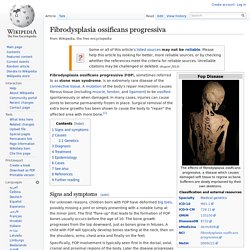
A mutation of the body's repair mechanism causes fibrous tissue (including muscle, tendon, and ligament) to be ossified spontaneously or when damaged. In many cases, injuries can cause joints to become permanently frozen in place. Surgical removal of the extra bone growths has been shown to cause the body to "repair" the affected area with more bone.[1] Signs and symptoms[edit] For unknown reasons, children born with FOP have deformed big toes, possibly missing a joint or simply presenting with a notable lump at the minor joint. Specifically, FOP involvement is typically seen first in the dorsal, axial, cranial and proximal regions of the body.
Capgras delusion. The delusion most commonly occurs in patients diagnosed with paranoid schizophrenia, but has also been seen in patients suffering from brain injury[4] and dementia.[5] It presents often in individuals with a neurodegenerative disease, particularly at an older age.[6] It has also been reported as occurring in association with diabetes, hypothyroidism, and migraine attacks.[7] In one isolated case, the Capgras delusion was temporarily induced in a healthy subject by the drug ketamine.[8] It occurs more frequently in females, with a female:male ratio of approximately 3:2.[9] Signs and symptoms[edit] The following two case reports are examples of the Capgras delusion in a psychiatric setting: Diane was a 28-year-old single woman who was seen for an evaluation at a day hospital program in preparation for discharge from a psychiatric hospital.
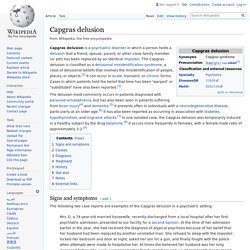
This was her third psychiatric admission in the past five years. Always shy and reclusive, Diane first became psychotic at age 23. Black Death. Spread of the Black Death in Europe (1346–53) The Black Death is thought to have originated in the arid plains of central Asia, where it then travelled along the Silk Road, reaching the Crimea by 1343.[6] From there, it was most likely carried by Oriental rat fleas living on the black rats that were regular passengers on merchant ships.

Spreading throughout the Mediterranean and Europe, the Black Death is estimated to have killed 30–60% of Europe's total population.[7] In total, the plague reduced the world population from an estimated 450 million down to 350–375 million in the 14th century. The aftermath of the plague created a series of religious, social, and economic upheavals, which had profound effects on the course of European history. It took 150 years for Europe's population to recover. Agraphesthesia. Autonomous sensory meridian response. A video intended to trigger ASMR.
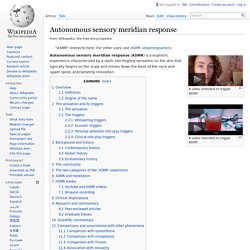
Macdonald triad. The Macdonald triad (also known as the triad of sociopathy or the homicidal triad) is a set of three behavioral characteristics that has been suggested, if all three or any combination of two, are present together, to be predictive of or associated with, later violent tendencies, particularly with relation to serial offenses.

The triad was first proposed by psychiatrist J.M. Macdonald in "The Threat to Kill", a 1963 paper in the American Journal of Psychiatry.[1] Small-scale studies conducted by psychiatrists Daniel Hellman and Nathan Blackman, and then FBI agents John E. Douglas and Robert K. Ressler along with Dr. Ann Burgess, claimed substantial evidence for the association of these childhood patterns with later predator behavior.[2] Although it remains an influential and widely taught theory, subsequent research has generally not validated this line of thinking.[3][4] Dunning–Kruger effect. Cognitive bias in which people with low ability at a task overestimate their ability.

Delusional parasitosis. Delusional parasitosis, also known as delusional infestation[1] or Ekbom's syndrome,[2][3] is a delusional disorder in which individuals incorrectly believe they are infested with parasites, insects, or bugs, whereas in reality no such infestation is present.[4] Individuals with delusional parasitosis usually report tactile hallucinations known as formication, a sensation resembling insects crawling on or under the skin.
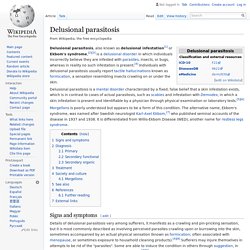
Delusional parasitosis is a mental disorder characterized by a fixed, false belief that a skin infestation exists, which is in contrast to cases of actual parasitosis, such as scabies and infestation with Demodex, in which a skin infestation is present and identifiable by a physician through physical examination or laboratory tests.[5][6] Morgellons is poorly understood but appears to be a form of this condition. Sympathetic ophthalmia. Sympathetic ophthalmia (SO) is a bilateral diffuse granulomatous uveitis (a kind of inflammation) of both eyes following trauma to one eye.

It can leave the patient completely blind. Symptoms may develop from days to several years after a penetrating eye injury. History[edit] It is thought that Louis Braille, who injured one of his eyes as a child, lost vision in his other eye owing to SO.[2] James Thurber's adult blindness was also diagnosed as sympathetic ophthalmia deriving from the loss of an eye when he was six years old.[3] Epidemiology[edit] Sympathetic ophthalmia is rare, affecting 0.2% to 0.5% of non-surgical eye wounds, and less than 0.01% of surgical penetrating eye wounds. Sleep paralysis. Sleep paralysis is a phenomenon in which an individual, either during falling asleep or awakening, temporarily experiences an inability to move, speak, or react.
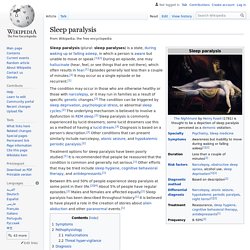
It is a transitional state between wakefulness and sleep, characterized by an inability to move muscles. It is often accompanied by terrifying hallucinations to which one is unable to react due to paralysis, and physical experiences (such as strong current running through the upper body). These hallucinations often involve a person or supernatural creature suffocating or terrifying the individual, accompanied by a feeling of pressure on one's chest and difficulty breathing. Another common hallucination type involves intruders (human or supernatural) entering one's room or lurking outside one's window, accompanied by a feeling of dread.
One hypothesis is that it results from disrupted REM sleep, which normally induces complete muscle atonia to prevent sleepers from acting out their dreams. Signs and symptoms[edit] Kuru (disease) Kuru is an incurable degenerative neurological disorder endemic to tribal regions of Papua New Guinea.

It is a type of transmissible spongiform encephalopathy, caused by a prion found in humans.[1] The term "kuru" derives from the Fore word "kuria/guria" ("to shake"),[2] a reference to the body tremors that are a classic symptom of the disease; it is also known among the Fore as the laughing sickness due to the pathologic bursts of laughter people would display when afflicted with the disease. It is now widely accepted that Kuru was transmitted among members of the Fore tribe of Papua New Guinea via cannibalism.[3] Kuru was first noted in the Fore tribes of Eastern Highlands and lowlands Provinces of Papua New Guinea as Australian administrators explored the area in 1953–1959.
Kuru (Keru) was reported by W. Awande Hospital was built in 1961 in the Eastern Highlands to accommodate kuru patients and research. In 1957, Dr. Subsequenty, E. List of genetic disorders. The following is a list of genetic disorders and if known, causal type of mutation and the chromosome involved. The list of human genes includes genes not listed here, which also affect predisposition toward certain diseases. More common disorders Full list[edit] Danger triangle of the face. The danger triangle of the face consists of the area from the corners of the mouth to the bridge of the nose, including the nose and maxilla.[1][2] (pp345–346)Due to the special nature of the blood supply to the human nose and surrounding area, it is possible for retrograde infections from the nasal area to spread to the brain causing cavernous sinus thrombosis, meningitis or brain abscess.